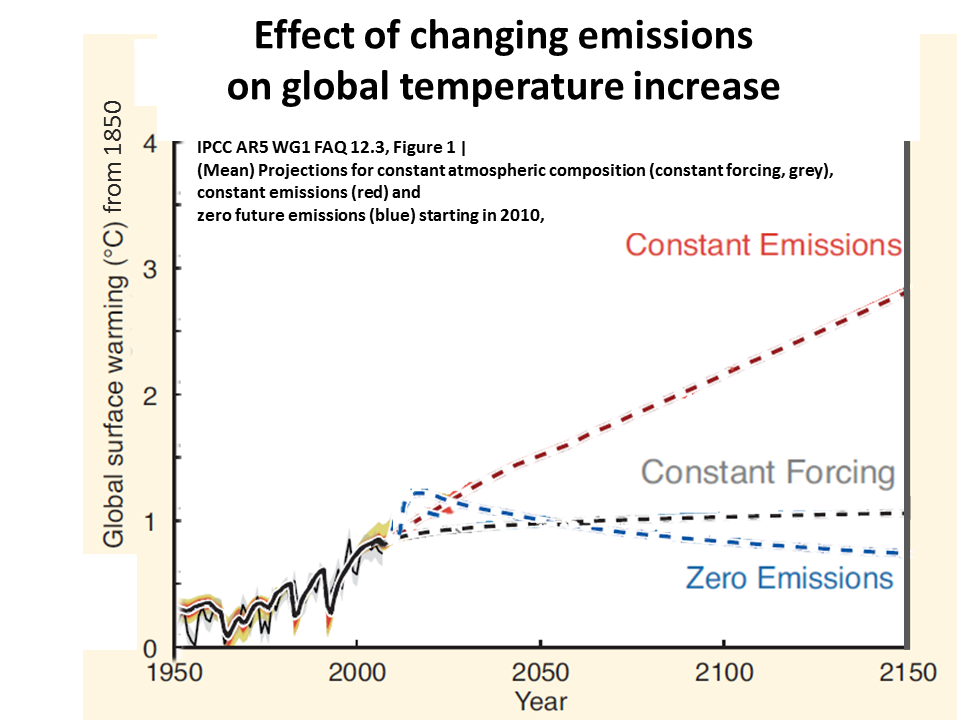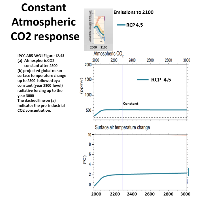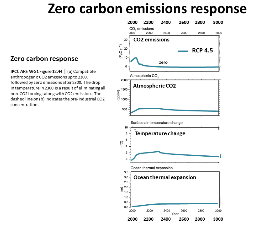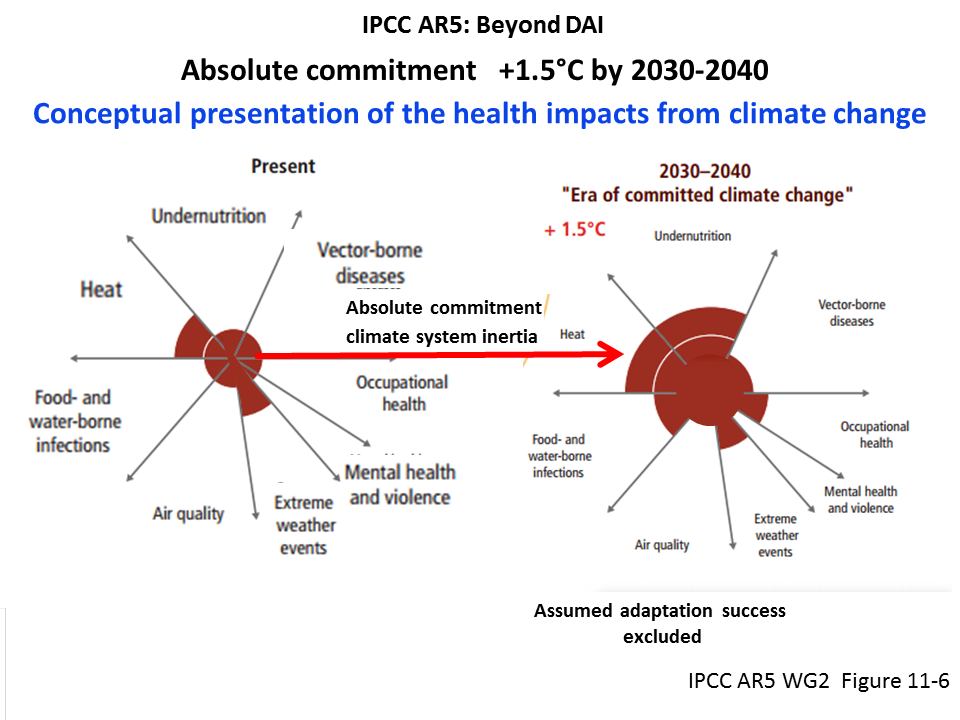ONLY ZERO CARBON ONLY ZERO CARBON ONLY ZERO CARBON ONLY ZERO CARBON ONLY ZERO CARBON ONLY ZERO CARBON ONLY ZERO CARBON ONLY
IPCC


IPCC AR5 on commitments




IPCC 5th assessment (AR5) 2014
Zero emissions required for mitigation
‘Pathways that are likely to limit warming to below 2°C relative to pre-industrial levels…
would require substantial emissions reductions over the next few decades and near zero emissions of carbon dioxide and other long-lived greenhouse gases by the end of the century.’ (AR5 SYN SPM Headline Statements)
CO2 lasts ‘for ever’
‘The removal of all the human-emitted CO2 from the atmosphere by natural processes will take a few hundred thousand years (high confidence) ‘(AR5 Ch6 6.1.1.1.)
‘About 15 to 40% of a CO2 pulse is still in the atmosphere after 1000 years.’ (AR5 Ch12 FAQ 12.3)
Unprecedented increase in atmospheric CO2
‘The recent rate of change [in atmospheric CO2] is dramatic and unprecedented; increases in CO2 never exceeded 30 ppm in 1 kyr – yet now CO2 has risen by 30 ppm in just the last 17 years’. (AR4 WG1 Science FAQ 7.1)
Atmospheric CO2 30% higher than 800,000 limit
‘Multiple lines of evidence confirm that the long-lived greenhouse gases CO2, CH4, N2O all have increased substantially since 1750.
There is very high confidence that they now exceed by 30%, 125%, 8%, respectively, the range of variability recorded in ice core records during past 800,000 years’.
Ocean Acidification
Earth System Models project a global increase in ocean acidification for all RCP scenarios (IPCC AR5 WG1 SPM p. 25)
Catastrophic ocean acidification for all but the best case emissions scenario.
[For all scenarios but the best-case (RCP2.6) emissions scenario], ‘ocean acidification poses substantial risks to marine ecosystems, especially polar ecosystems and coral reefs, associated with impacts on the physiology, behavior, and population dynamics of individual species from phytoplankton to animals. […] Ocean acidification acts together with other global changes (e.g., warming, decreasing oxygen levels) and with local changes (e.g., pollution, eutrophication [algae overgrowth]) (high confidence)’.
(AR5 WG2 SPM p. 17)
Amplifying carbon feedback responses to global warming
(global warming feedbacks increase global warming)
• ‘Carbon stored in the terrestrial biosphere is susceptible to loss to the atmosphere as a result of climate change, deforestation, and ecosystem degradation.
• ‘The aspects of climate change with direct effects on stored terrestrial carbon include high temperatures, drought and windstorms; indirect effects include increased risk of fires, pest and disease outbreaks.’
• ‘Increased tree mortality and associated forest dieback is projected to occur in many regions over the 21st century posing risks for carbon storage
• There is a high risk of substantial carbon and methane emissions as a result of permafrost thawing.’ (AR5 SYN Long-27)
‘Examples that could lead to substantial impact on climate [i.e., amplifying carbon feedback]
• The boreal-tundra Arctic system and the Amazon forest. Carbon stored in the terrestrial biosphere (e.g., in peatlands, permafrost, and forests) is susceptible to loss to the atmosphere [i.e amplifying carbon feedback] as a result of climate change, deforestation, and ecosystem degradation
• Increased tree mortality and associated forest dieback is projected to occur in many regions over the 21st century, due to increased temperatures and drought. Forest dieback poses risks for carbon storage and biodiversity.’
(AR5 WG2 SPM p. 15)
‘Pathways that are likely to limit warming to below 2°C relative to pre-industrial levels…
would require substantial emissions reductions over the next few decades and near zero emissions of carbon dioxide and other long-lived greenhouse gases by the end of the century.’ (AR5 SYN SPM Headline Statements)
CO2 lasts ‘for ever’
‘The removal of all the human-emitted CO2 from the atmosphere by natural processes will take a few hundred thousand years (high confidence) ‘(AR5 Ch6 6.1.1.1.)
‘About 15 to 40% of a CO2 pulse is still in the atmosphere after 1000 years.’ (AR5 Ch12 FAQ 12.3)
Unprecedented increase in atmospheric CO2
‘The recent rate of change [in atmospheric CO2] is dramatic and unprecedented; increases in CO2 never exceeded 30 ppm in 1 kyr – yet now CO2 has risen by 30 ppm in just the last 17 years’. (AR4 WG1 Science FAQ 7.1)
Atmospheric CO2 30% higher than 800,000 limit
‘Multiple lines of evidence confirm that the long-lived greenhouse gases CO2, CH4, N2O all have increased substantially since 1750.
There is very high confidence that they now exceed by 30%, 125%, 8%, respectively, the range of variability recorded in ice core records during past 800,000 years’.
Ocean Acidification
Earth System Models project a global increase in ocean acidification for all RCP scenarios (IPCC AR5 WG1 SPM p. 25)
Catastrophic ocean acidification for all but the best case emissions scenario.
[For all scenarios but the best-case (RCP2.6) emissions scenario], ‘ocean acidification poses substantial risks to marine ecosystems, especially polar ecosystems and coral reefs, associated with impacts on the physiology, behavior, and population dynamics of individual species from phytoplankton to animals. […] Ocean acidification acts together with other global changes (e.g., warming, decreasing oxygen levels) and with local changes (e.g., pollution, eutrophication [algae overgrowth]) (high confidence)’.
(AR5 WG2 SPM p. 17)
Amplifying carbon feedback responses to global warming
(global warming feedbacks increase global warming)
• ‘Carbon stored in the terrestrial biosphere is susceptible to loss to the atmosphere as a result of climate change, deforestation, and ecosystem degradation.
• ‘The aspects of climate change with direct effects on stored terrestrial carbon include high temperatures, drought and windstorms; indirect effects include increased risk of fires, pest and disease outbreaks.’
• ‘Increased tree mortality and associated forest dieback is projected to occur in many regions over the 21st century posing risks for carbon storage
• There is a high risk of substantial carbon and methane emissions as a result of permafrost thawing.’ (AR5 SYN Long-27)
‘Examples that could lead to substantial impact on climate [i.e., amplifying carbon feedback]
• The boreal-tundra Arctic system and the Amazon forest. Carbon stored in the terrestrial biosphere (e.g., in peatlands, permafrost, and forests) is susceptible to loss to the atmosphere [i.e amplifying carbon feedback] as a result of climate change, deforestation, and ecosystem degradation
• Increased tree mortality and associated forest dieback is projected to occur in many regions over the 21st century, due to increased temperatures and drought. Forest dieback poses risks for carbon storage and biodiversity.’
(AR5 WG2 SPM p. 15)